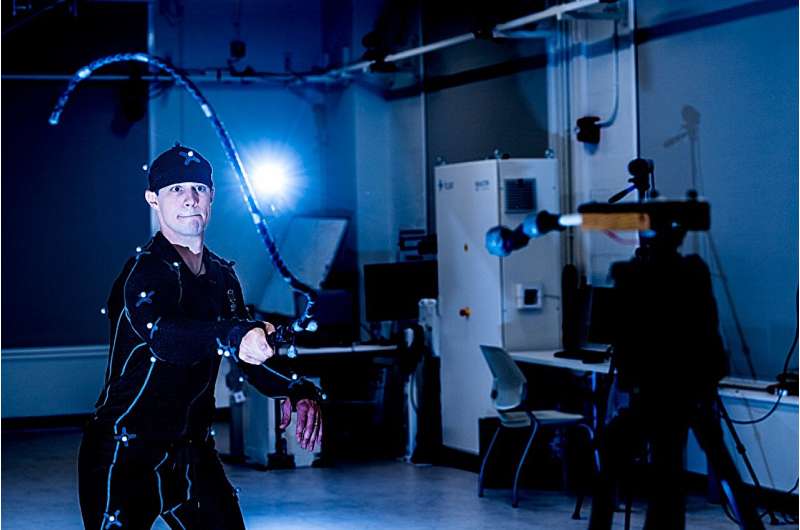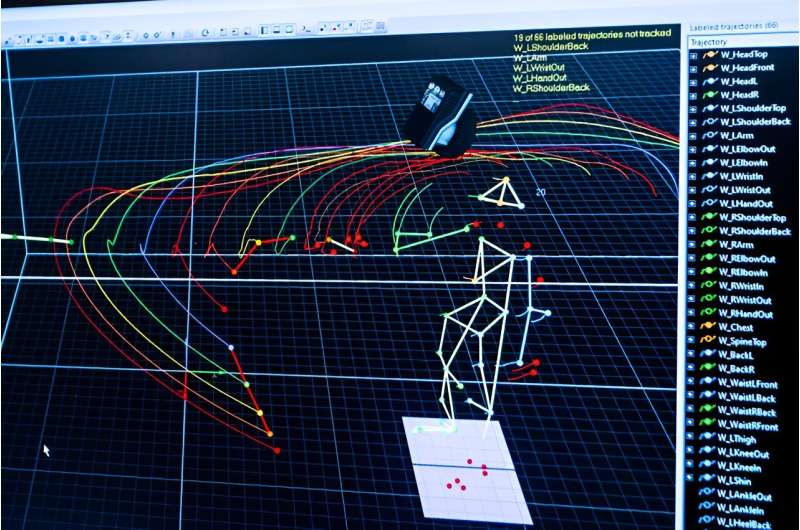This article has been reviewed according to Science X's editorial process and policies. Editors have highlighted the following attributes while ensuring the content's credibility:
fact-checked
trusted source
proofread
Could robots control whips? Researchers test the extremes of human motor control to advance robotics

On any given day, Richards Hall on Northeastern University's Boston campus is filled with the sound of students' shuffling feet or energetic class discussions, but this week you might have heard something else: a whip cracking.
The man responsible for that distinct cracking sound is Jack Lepiarz, aka Jack the Whipper, a trained whip performer who has become famous on social media.
As part of their work on human movement control, Dagmar Sternad, university distinguished professor of biology, electrical and computer engineering and physics, and her research group at Northeastern's Action Lab are looking at the movements of experts like Lepiarz, as well as whip cracking novices, to understand how humans manipulate complex objects, like whips.
"The goal in our lab is to study human behavior in complex tasks that go beyond the simple movement tasks that have been studied in movement neuroscience like simple point-to-point reaching," says Mahdiar Edraki, a Ph.D. student in the Action Lab. "Yes, you can understand a lot about such experimentally controlled movements, but they don't give you much insight about what humans do in the real world. That's where our lab comes in, and this [research] is a great example of it."
There are many complex movements and object interactions we take for granted, like tying our shoelaces or folding a blanket. By understanding the dynamics behind these actions, the researchers hope to gain new insight into the ways humans interact with the world.
"Sometimes you will see people carrying a bag of groceries and, for example, kids would be swinging it back and forth," says Aleksei Krotov, another Ph.D. student in the Action Lab who is leading the whip study. "This is probably a way of how we learn about objects that we interact with."
The researchers hope their human-centered work can aid with robotic applications, which is where whips come into play. Whips are flexible and wobbly and involve complex interplay between the forces generated by the whip and the person using the whip.
Currently, robots aren't able to do anything close to the kind of fine-tuned motor control humans exert when handling whips.
"The traditional ways of controlling a robot to manipulate an object doesn't apply here," Edraki says. "The robot needs to understand what to expect from this object when force is applied to it, so that's where the challenges come in. Aside from our human studies, we're also developing new techniques to understand how a robot can interact with this object."
Edraki and Krotov have collected data from more than 40 novice participants. They've also brought in people like Lepiarz and another whip performer, Adam Winrich, to see how much more skillfully an expert can manipulate a whip.
In order to capture the movement of the whip and their subjects, the researchers created an almost 5.5-foot long bullwhip and covered it in reflective motion capture markers. The participants wear a skin-tight motion capture suit that is also covered in sensors. The researchers then task them with trying to hit a target in different situations, including when blindfolded.

They use 20 state-of-the-art motion capture cameras to capture every movement of the body and every unfurling of the whip, which is reconstructed digitally, giving them all the data points they need.
It is similar to how the visual effects artists at Weta Workshop created Gollum using the movements of actor Andy Serkis for "The Lord of the Rings" and "The Hobbit" movies –– except with more whips.
Krotov says they have noticed even people who have never used a whip before are able to unfold it with surprising fluidity.
"Once we have the data, it [involves] a lot of analysis of how coordinated the different body movements and the whip movements are coordinated, to extract if they conform to patterns such as a smooth unfolding of the whip," Krotov says.
However, someone like Lepiarz gives the researchers in the Action Lab a different level of insight into the finer points of motor control. The son of a circus performer, Lepiarz has been cracking whips since he was 7 years old. When he was 17, his father gave him his first whip for Christmas, "like normal parents do."
"With a target, I'm not trying to crack it as hard as I can," Lepiarz says. "I'm trying to get it as controlled as I can straight up and straight down, and I'll do this little twist with my wrist as I come down to help keep it straight. That's what proper technique with the whip cracking can do because there's almost no muscle [put] into that and there's still a crack."
Lepiarz says he is always aware of the whip's formation before he swings it, even when it's behind his head. That is vital information, especially for someone who not only swings two whips at once but sometimes lights them on fire, too.
"There's a slight pull on the handle," Lepiarz says. "Whereas if I don't feel that pull and I go to bring it forward, it's going to get me across the back or across the back of the neck."
Beyond robotics, Sternad says understanding the science behind manipulating a whip could not only render new insights for neuroscience and robotics but also for clinical science, in the case of stroke patients, for example.
"One of the first goals for stroke patients is to re-learn to interact with objects because they need to feed themselves and to clothe themselves," Sternad says. "We are using tasks like transporting a cup of coffee in order to evaluate the severity of impairment. It's a very sensitive task for assessments, better than just placing a block from A to B. We have several lines of attack on that problem."
Regaining actions like moving a cup of coffee is one of the first goals of physical and occupational therapy. More fundamental understanding of how humans interact with complex objects, like a whip, may ultimately help improve therapy and care for neurologically impaired individuals, Sternad says.




















